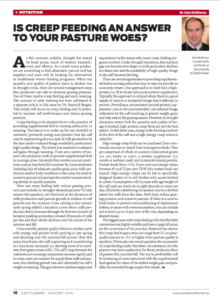Is Creep Feeding an Answer to Your Pasture Woes?
This article written by Dr. John McKinnon, University of Saskatchewan beef cattle nutrition researcher and professor, originally appeared in the August 2015 issue of Canadian Cattlemen magazine and is reprinted on the BCRC Blog with permission of the publisher.
Remarque : cette page web n’est actuellement disponible qu’en anglais.
As this summer unfolds, drought has reared its head across much of western Saskatchewan and Alberta. As a result many producers are scrambling to find alternative pasture and hay supplies and soon will be looking for alternatives to traditional winter-feeding programs. When the quantity and quality of pasture starts to decline due to drought stress, there are several management steps that producers can take to decrease grazing pressure. Two of these involve creep feeding and early weaning. The concept of early weaning has been addressed in a separate article in this issue by Dr. Reynold Bergen. This article will focus on creep feeding and its potential to increase calf performance and reduce grazing pressure.
Creep feeding in its simplest form is the practice of providing supplemental feed to nursing calves prior to weaning. The intent is to make up for any shortfall in nutrients (primarily energy and protein) that the calf may be experiencing due to a lack of milk production by the dam and/or reduced forage availability, particularly high-quality forage. The intent is to maintain or enhance calf gains through weaning. There are a variety of reasons why producers look to provide supplemental feed to nursing calves. Generally they revolve around conditions such as that faced this summer by many producers including lack of adequate-quality grass, poor milk production and/or body condition in the cows, the need to conserve pasture and perhaps the need to increase stocking density in specific pastures.
How can creep feeding help reduce grazing pressure, particularly on drought-stressed pastures? To help answer this question, let’s first look at the dynamics of milk production and pasture growth in relation to calf growth over the summer. Cows calving in late winter/ early spring exhibit a lactation curve where milk production slowly increases through the first two months of lactation peaking somewhere around 20 pounds of milk per day and then slowly declines over the course of the summer and fall.
Concurrently, pasture quality follows a similar curve with energy and protein levels peaking in late spring and declining over the summer/fall period. Over this same time frame, the calf is growing and transitioning to a functional ruminant (i.e. deriving more of its nutrients from grass versus milk). The calf ’s requirements for nutrients such as energy and protein increase rapidly and in many cases can outpace the supply from milk and pasture, thus limiting growth rate and ultimately the calf’s weight at weaning. This gap between nutrient supply and requirement is the reason why many creep-feeding programs evolved. Under drought situations, this nutrient gap can become even larger as milk production declines at a faster rate and the availability of high-quality forage to the calf becomes limiting.
There are several approaches to providing supplemental feed to nursing calves that may or may not provide an economic return. One approach is to limit feed a high- protein (i.e. 30 to 40 per cent crude protein) supplement. Typically this approach is utilized where there is a good supply of mature or stockpiled forage that is deficient in protein. Providing a concentrated natural protein supplement (urea is not recommended) can enhance forage utilization by the calf resulting in greater weight gains and help extend the grazing season. However, in drought situations where both the quantity and quality of forage is limited, high-protein creep feeds are not the best option. In this latter case, energy is the limiting nutrient in the diet of the calf and a high-energy creep ration is called for.
High-energy creep feeds can be purchased from commercial sources or mixed from home-grown feeds. They are comprised of whole or coarsely rolled cereal grains (i.e. oat, barley or corn), a protein supplement (i.e. canola or soybean meal) and a mineral/vitamin premix. Protein levels from 13 to 16 per cent and energy values between 65 and 75 per cent TDN (dry matter basis) are typical. High-energy creeps can be fed in specifically designed feeders or in self-feeders with access limited to calves. Consumption will increase with age/weight of the calf and can reach six to eight pounds or more per day, effectively substituting for pasture and to a limited extent for milk from the dam. Both help reduce grazing pressure and conserve pasture. If there is a need to limit intake to prevent overconditioning of replacement heifers, or issues with overconsumption, one can include salt at levels up to 15 per cent of the mix, depending on desired intake.
The biggest issue with creep feeding is the fact that feed conversions are highly variable and have a large influence on the economics of the practice. Research has shown that creep feed to gain ratios can range from 5:1 on poor-quality pasture to 15:1 or higher when pasture quality is excellent. Obviously one would question the economics of creep feeding under this latter circumstance, but the practice may have application for those producers short of pasture this summer/fall. The key to profitability will be balancing all costs associated with the supplemental feed against the value of the added weight gain and possibly the extended forage supply that results.
Click here to subscribe to the BCRC Blog and receive email notifications when new content is posted.
The sharing or reprinting of BCRC Blog articles is typically welcome and encouraged, however this article requires permission of the original publisher.
We welcome your questions, comments and suggestions. Contact us directly or generate public discussion by posting your thoughts below.
